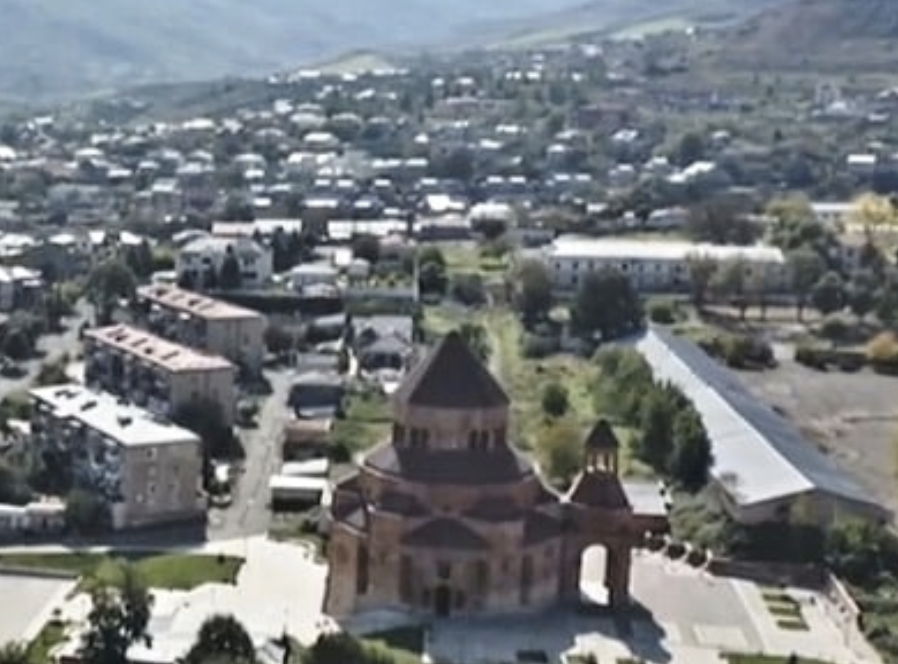Last month’s election of Azerbaijan to a senior position of the United Nations’ cultural body has raised concern regarding the fate of cultural monuments in Nagorno-Karabakh, given the organization’s responsibility to protect cultural heritage around the world.
Following Azerbaijan’s forced displacement of more than 100,000 ethnic Armenians last month, this additional development further increases the potential that Armenian cultural heritage, which notably includes the Amaras, Gandzasar, and Dadivank monasteries as well as the “We Are Our Mountains” statue, will be destroyed or appropriated.
Amaras Monastery is one of the world’s oldest Christian monuments and is the site of the first school opened by the creator of the Armenian alphabet. These cultural sites are important not only for their history, but their art, architecture, and religious symbology. In Hadrut, a region of Nagorno-Karabakh retaken by Azerbaijan in the 2020 war, an Armenian church was destroyed. According to a Caucasus Heritage Watch report, the destruction of the relatively modest church, St. Sargis of Mokhrenes, is the first documented violation of the ICJ ruling by Azerbaijan.
While the public is most concerned with these more well-known cultural landmarks, the greatest risk is to the smaller sites that are not as famous, according to Caucasus Heritage Watch co-founder Dr. Lori Khatchadourian. It is unlikely that the Azerbaijani government, which has demonstrated little regard for the lives of civilians in Nagorno-Karabakh or Armenian culture in other parts of the region, will take steps to preserve these monuments.
Within weeks of near-totally depopulating Nagorno-Karabakh, Azerbaijani President Ilham Aliyev paid a visit to the region in which he raised the Azerbaijani flag and repeatedly walked over the region’s flag in what was likely an attempted show of strength. Then, in early November, the Azerbaijani military paraded through the capital of Nagorno-Karabakh, and officials announced that they would resettle more than 100,000 Azerbaijani people to the region, heightening the risk of destruction of Armenian cultural heritage.
Most recently, video footage from an Azerbaijani media outlet indicates that the crosses have been removed from the domes of the Armenian Holy Mother of God Cathedral in Stepanakert.

A video frame from Azerbaijani media indicates that the crosses have been removed from an Armenian church in Nagorno-Karabakh. (CREDIT: News.am)
Organizations such as All for Armenia have called for UNESCO to protect Armenian cultural sites. This is not the first time that organizations have lobbied for the preservation of Armenian cultural sites at risk of destruction by Azerbaijan. In past years, several efforts, including an international conference in Austria, have taken place to raise awareness and garner support for the preservation of Armenian cultural heritage.
These endeavors have taken place partly in response to reports, including by the Caucasus Heritage Watch, which use satellite imagery to show that the Azerbaijani government has quietly and systematically destroyed sites connected with Armenian heritage over several years. In the Nakhchivan region alone, Azerbaijan’s destruction of thousands of cultural monuments, including the Jugha Cemetery has taken place with relative impunity, despite the 1954 Hague Convention which obliges state parties such as Azerbaijan to “refrain from all acts of hostility directed against [cultural property].”
Khatchadourian tells CivilNet that there are multifaceted risks to Armenian cultural heritage in Nagorno-Karabakh faces, including intentional cultural erasure, collateral destruction as part of development, and the falsification of Armenian cultural heritage sites as Caucasian Albanian. Khatchadourian explained that the latter is a form of interpretive violence that can also be physical if inscriptions are erased or other elements destroyed to make the site fit Azerbaijan’s false narrative.
Based on Caucasus Heritage Watch’s years of research in the region, these risks are long-term, requiring continued monitoring and pressure from the international community to preserve Armenian cultural heritage. In response, the organization will be expanding its satellite coverage to include the monuments in Nagorno-Karabakh that came under Azerbaijani control in September.
Despite Azerbaijan being provisionally ordered to “take all necessary measures to prevent and punish acts of vandalism and desecration affecting Armenian cultural heritage” by the International Court of Justice in 2021, the government continued its policy of destruction and historical revisionism.
While the United States acknowledged Azerbaijan’s violations in the Department of State’s 2022 Report on International Religious Freedom, little concrete action has taken place to hold anyone accountable or prevent the future destruction of Armenian cultural sites. Azerbaijan taking a formal leadership role at UNESCO will increase the difficulty of securing any meaningful protection for Armenian cultural heritage in Nagorno-Karabakh.
All of this considered, the fear of a gradual “cultural genocide” is warranted, especially given Azerbaijan’s reputation of wiping out Armenian cultural sites or changing the context of those sites not destroyed in a broader attempt to rewrite the history of the region. Without unbiased, international cooperation backed by enforcement, it is likely that the cultural heritage of Armenia in areas controlled by Azerbaijan will continue to be at risk.
The post Cultural Heritage at Risk in Nagorno-Karabakh appeared first on CIVILNET.